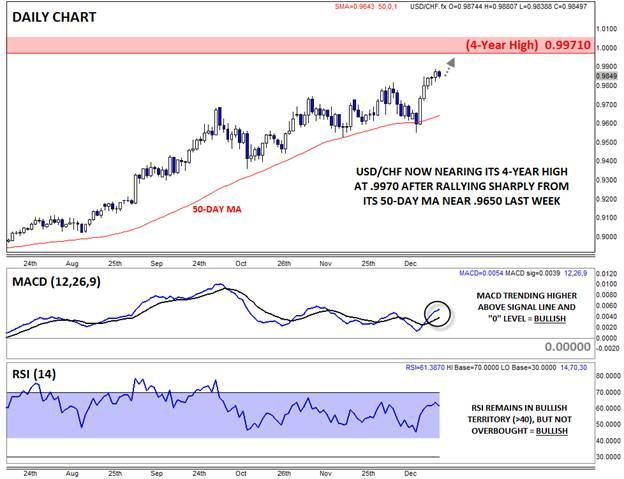![]()
Yesterday, we discussed how the SNB’s decision to cut Swiss interest rates to negative had only a short-lived effect on EURCHF (see “The SNB Gave EURCHF its Heart but EURCHF Gave it Away†for more). The impact was minimal because both the Eurozone and Switzerland now have negative interest rates and dovish central banks, to say nothing of the likelihood that the SNB’s decision was already priced into the market.
That said, Switzerland’s decision to go negative has had an impact on USDCHF, which spiked sharply last week. To draw a contrast with EURCHF, the direction of monetary policies in the US and Switzerland could not be more different. After yesterday’s jaw-dropping US GDP reading of 5.0%, the Fed is almost certain to raise interest rates early next year, while the SNB, for better or worse, will likely follow the ECB’s dovish actions in 2015.
On a technical basis, USDCHF’s bias is clearly higher. The pair has consistently found support at its 50-day MA since July, including just last week; that key floor now sits near .9650, suggesting that the market may be eager to buy on any near-term dips in the pair. Meanwhile, the secondary indicators are also painting a bullish picture: the MACD is once again trending higher above its signal line and the “0†level, showing clearly bullish momentum, while the RSI indicator remains in bullish territory (>40), but not yet overbought.
Given the bullish fundamental and technical outlook, USDCHF may extend its rally heading into the end of the year. To the topside, the next major level of resistance is the 4-year high at .9970, though the previous resistance levels stretch all the way up to the November 2010 high at 1.0070. As long as rates stay above strong support at the 50-day MA, the parity (1.00) level could be in play for USDCHF sooner rather than later.
This research is for informational purposes and should not be construed as personal advice. Trading any financial market involves risk. Trading on leverage involves risk of losses greater than deposits.
Recommended Content
Editors’ Picks
EUR/USD trades with negative bias, holds above 1.0700 as traders await US PCE Price Index

EUR/USD edges lower during the Asian session on Friday and moves away from a two-week high, around the 1.0740 area touched the previous day. Spot prices trade around the 1.0725-1.0720 region and remain at the mercy of the US Dollar price dynamics ahead of the crucial US data.
USD/JPY jumps above 156.00 on BoJ's steady policy

USD/JPY has come under intense buying pressure, surging past 156.00 after the Bank of Japan kept the key rate unchanged but tweaked its policy statement. The BoJ maintained its fiscal year 2024 and 2025 core inflation forecasts, disappointing the Japanese Yen buyers.
Gold price flatlines as traders look to US PCE Price Index for some meaningful impetus

Gold price lacks any firm intraday direction and is influenced by a combination of diverging forces. The weaker US GDP print and a rise in US inflation benefit the metal amid subdued USD demand. Hawkish Fed expectations cap the upside as traders await the release of the US PCE Price Index.
Sei Price Prediction: SEI is in the zone of interest after a 10% leap

Sei price has been in recovery mode for almost ten days now, following a fall of almost 65% beginning in mid-March. While the SEI bulls continue to show strength, the uptrend could prove premature as massive bearish sentiment hovers above the altcoin’s price.
US economy: Slower growth with stronger inflation

The US Dollar strengthened, and stocks fell after statistical data from the US. The focus was on the preliminary estimate of GDP for the first quarter. Annualised quarterly growth came in at just 1.6%, down from the 2.5% and 3.4% previously forecast.
